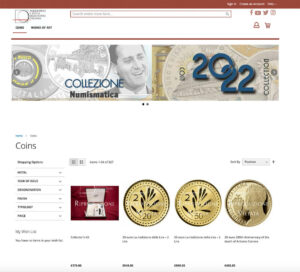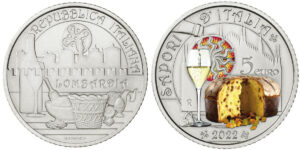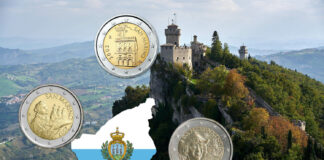
Italy’s coins stand out due to their exceptional quality. It’s not for nothing that the Italian Mint is one of just a few in the world to train engravers at its own school. A luxury? Certainly. But one that pays off, as it seems. In Rome, aesthetic quality is skilfully combined with technical innovation. Think of the first modern bi-metal circulation coin, issued by Italy in 1982. The 500-lire piece was a sensation.
Italians prove time and again that they know what appeals to collectors. The best example for this are the highly successful colour sets of recent years. Customers virtually scrambled for the sets, which included three coins each in one of Italy’s national colours – red, white and green. Three times, Italy combined these colour sets with topics that were highly popular with collectors: 2019 with the Vespa cult scooter, in 2020 with the legendary Olivetti typewriter brand and in 2021 with the Nutella spread. In 2020, Italy made a daring move: an entire colour series dedicated to what’s perhaps the most Italian topic of all – food.

The New Online Shop: Buying Italy’s Coins First Hand
Before you start wondering why this might be of any interest to you since you won’t get your hands on Italian coins anyway: there’s exciting news for international collectors! Although IPZS has been offering all collector coins online for years, there was a catch: the offer was limited to customers residing in Italy. If you wanted to buy Italian coins from abroad, you had to find other ways to do so and hope for the highly popular coins to still be available from middlemen. This is over now.
Since the beginning of December, the online shop has been available in English to international customers, who can now directly purchase all IPZS products from the website. Once again, the Italian mint complied with the requests of collectors. You can also find the latest culinary coloured coins, there! Prego!
Italian Dinner Is Served!
In Italy, food is about much more than fuelling your body with nutrients. In the belpaese, a meal is to be enjoyed, or even celebrated. Eating is a social event that is an integral part of the nation’s identity, defined by the ingredients and the history of every region. By means of recipes and preparation methods, every area, even every village distinguishes itself from the rest. The question of which type of sheep’s milk cheese is grated over pasta – a Roman, a Tuscan, a Sardinian one… – is almost a political issue.
Against this background, the Italian mint introduced the “Cultura enogastronomica italiana” series in 2020, i.e. a series celebrating the Italian food and wine culture. Each issue is dedicated to a specific region and showcases famous monuments in the background with culinary treasures standing out in colour in front of it. In this way, the series also has an educational mission (and addresses a broad collecting audience by exclusively issuing cupronickel versions of the 5-euro coins). After all, while people in Italy are well aware of the culinary riches that can be enjoyed from the Alps to Sicily, foreigners often reduce Italian food to pasta and pizza. What a mistake – as these coins teach us!
The first coin was dedicated to the region of Campania and was chosen cleverly: pizza, here in its Neapolitan form, is perhaps considered the most popular dish in the world. This issue was launched with a mintage figure of 8,000 pieces.
In the next year, the issues for Emilia Romagna (tortellini!) and Sicily (cannolo – a Sicilian pastry packed with calories) with as many as 12,000 specimens each were released. The Italians had thus reacted to the enormous interest. The engraver Maria Carmela Colaneri – who held a permanent position at the mint in Rome – had hit the mark with her fresh, clear design and the crisp but tasteful use of colour. She retired in 2021 and the Italian numismatic press was worried about whether her successor would be able to keep up with her standards.
However, it turned out that there was no need to worry. The latest issues of 2022 were designed by Marta Bonifacio with as much skill as those of her predecessor. And just like her, Bonifacio too holds a permanent position as an engraver at the Istituto Poligrafico e Zecca dello Stato (IPZS). That’s the name of the institution that produces all official documents of Italy – from passports to alcohol labels. Since 1978, the mint and the School of the Art of Medalmaking have been part of the IPZS.

2022: Lombardy and Apulia
Let’s take a look at the two new additions to the table presenting Italy’s delicacies. In 2022, one region from the north was combined with one of the south: Lombardy and Apulia. And, once again, the mintage figure was increased to 15,000 specimens.
In line with the character of the series, one side features silhouettes and contours of monuments and other elements that are typical of the region. Only the other side has coloured elements, namely the protagonists: the most famous delicacies of the region.
Among other things, Lombardy is represented by the silhouettes of the Ducal Palace of Mantua and the Milan Cathedral, with the ingredients of a panettone in the foreground. This traditional Christmas pastry with candied fruit can be seen in colour on the coin’s other side, cut and accompanied by a glass of spumante from Franciacorta, the champagne of northern Italy. The so-called Camunian rose in the background is the symbol of Lombardy, one of Italy’s most prosperous economic regions.

On one side, Apulia is represented by trulli, circular houses with pointed roofs that were declared UNESCO World Heritage Sites. The waves and the dolphin below not only refer to the incredible popularity that the region on the Adriatic Sea enjoys among Italian and foreign tourists when it comes to vacation destinations. Even in ancient times, the Greek in Taranto (which is located in today’s Apulia) adorned their silver coins with the dolphin.
The other side is dominated by a glass of ruby wine from primitivo grapes. Behind it are olives, from which high-class virgin olive oil is made in Apulia – DOC (di origine controllata), i.e. controlled designation of origin. In front of the Altamura bread with its crispy brown crust we see what’s perhaps the most popular product of Apulian cuisine: orecchiette pasta, which are traditionally served with a special type of cabbage.
When issuing a new coin series, many mints give an overview of the planned issues. The Italians don’t. It will be exciting to see what the next regions are. There is no doubt that the brightly coloured coins are ambassadors DOC for Italy’s culture and the Italian way of life.
A New Culture of Coin Designs
Are you still surprised to see pasta and pizza on coins? Italy’s series is an expression of a new understanding of coin designs that did not emerge until the 80s and 90s. Previously, “great minds” had dominated coin designs, usually men: politicians and generals, poets and thinkers, in short, the so-called “high culture”. Mundane themes from everyday life were about as frowned upon as Donald Duck in the study of literature. But with the rise of coins that were specifically issued for collectors, motifs gradually changed too: actors and athletes, animals and nature established themselves. Even in 2022, series such as that on Italian cuisine still play a pioneering role. Or could you imagine, for example, sausage and kale on Germany’s new 5-euro coins, followed by pork roast with German dumplings? In 2019, a currywust on a German collector issue was rather met with ridicule than encouragement. You see: not all countries do overcome the traditional catalogue of themes at the same pace and perceive food, for example, as an integral part of one’s culture that is well worth of being celebrated by a coin.
Lira 2.0
Alongside innovations, tradition is what Italy’s sophisticated coinage stands for. Even in euro times, the country likes to recall the lira, which shaped the country’s history for decades. In 2021, the first issue of the “La riedizione della Lira” series (“Re-issuing the Lira”) was released. The engraver Maria Angela Cassol interpreted the 1-lira design of 1951 seventy years later using current technology, in 2022 the 2-lira coin of 1953 followed with bee and olive branch.
For the first time in Italy, reverse proof technology was applied for this bow to Italy’s post-war coins. In the normal proof process, a frosted relief arises from a polished ground. Regarding reverse proof, it’s the other way around. The bee and the other elements of the relief protrude polished from the frosted surface.
The Lira series presents itself in the form of elegant gold issues and every year the coin is issued once as a 20-euro version and once as a 50-euro coin. These face values were elegantly incorporated into the historical design.
In our database, you can find all the coins of the Cultura enogastronomica italiana series. You can also find other Italian euro coins there.
(The coin of Puglia will be available from 28 December 2022, while the coin of Lombardy from 16 May 2023.)






